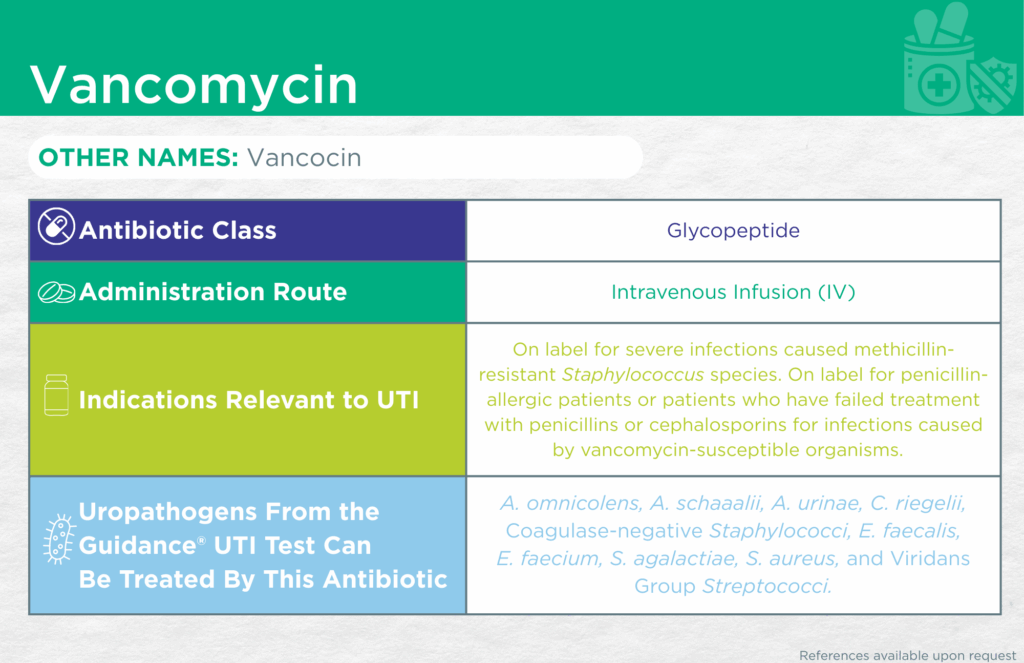Vancomycin

Emery Haley, PhD, Scientific Writing Specialist
Vancomycin
Find the Latest FDA-Approved Labelling Information Here: Drugs@FDA Online Database
Administrative Routes
Parenteral [intravenous infusion (IV)]
Other Names
Vancocin
Bacteriostatic or Bactericidal
Bactericidal [1]
Antibiotic Class
Glycopeptide
Mechanisms of Action
Vancomycin binds to D-alanyl D-alanine in the bacterial cell wall, inhibiting peptidoglycan polymerization. Failure of peptidoglycan cell wall synthesis causes bacterial cell death.
WHO AWaRe Classification
Watch [2]
Empiric Use Recommendations
No published guidance
Indication(s) Relevant to UTI
On label for severe infections caused by methicillin-resistant Staphylococcus species.
On label for penicillin-allergic patients or patients who have failed treatment with penicillins or cephalosporins for infections caused by vancomycin-susceptible organisms.
Checkmarks
CLSI and/or FDA documents support the efficacy of this antibiotic against the following organisms from the Guidance® UTI test: Aerococcus urinae, Corynebacterium riegelii, Coagulase-negative Staphylococci, Enterococcus faecalis, Enterococcus faecium, Streptococcus agalactiae, Staphylococcus aureus, and Viridans Group Streptococci.
Published primary literature supports the efficacy of this antibiotic against the following organisms from the Guidance® UTI test: Alloscardovia omnicolens [3], and Actinotignum schaalii [4-6]
- Ishak, A.; Mazonakis, N.; Spernovasilis, N.; Akinosoglou, K.; Tsioutis, C. Bactericidal versus Bacteriostatic Antibacterials: Clinical Significance, Differences and Synergistic Potential in Clinical Practice. J. Antimicrob. Chemother. 2024, 80, 1–17, doi:10.1093/jac/dkae380
- AWaRe Classification of Antibiotics for Evaluation and Monitoring of Use, 2023 Available online: https://www.who.int/publications/i/item/WHO-MHP-HPS-EML-2023.04 (accessed on 6 February 2025).
- Isnard, C.; Lienhard, R.; Reissier, S.; Rodriguez, S.; Krähenbühl, J.; Liassine, N.; Guérin, F.; Cattoir, V. In Vitro Antimicrobial Susceptibility of Alloscardovia Omnicolens and Molecular Mechanisms of Acquired Resistance. Diagnostic Microbiology and Infectious Disease 2016, 84, 227–229, doi:10.1016/j.diagmicrobio.2015.08.009.
- Lotte, R.; Lotte, L.; Ruimy, R. Actinotignum Schaalii (Formerly Actinobaculum Schaalii): A Newly Recognized Pathogen—Review of the Literature. Clin Microbiol Infec 2016, 22, 28–36, doi:10.1016/j.cmi.2015.10.038.
- Cattoir, V.; Varca, A.; Greub, G.; Prod’hom, G.; Legrand, P.; Lienhard, R. In Vitro Susceptibility of Actinobaculum Schaalii to 12 Antimicrobial Agents and Molecular Analysis of Fluoroquinolone Resistance. J Antimicrob Chemoth 2010, 65, 2514–2517, doi:10.1093/jac/dkq383.
- Sahuquillo-Arce, J.M.; Suárez-Urquiza, P.; Hernández-Cabezas, A.; Tofan, L.; Chouman-Arcas, R.; García-Hita, M.; Sabalza-Baztán, O.; Sellés-Sánchez, A.; Lozano-Rodríguez, N.; Martí-Cuñat, J.; et al. Actinotignum Schaalii Infection: Challenges in Diagnosis and Treatment. Heliyon 2024, 10, e28589, doi:10.1016/j.heliyon.2024.e28589.
Dr. Emery Haley is a scientific writing specialist with over ten years of experience in translational cell and molecular biology. As both a former laboratory scientist and an experienced science communicator, Dr. Haley is passionate about making complex research clear, approachable, and relevant. Their work has been published in over 10 papers and focuses on bridging the gap between the lab and real-world patient care to help drive better health outcomes.